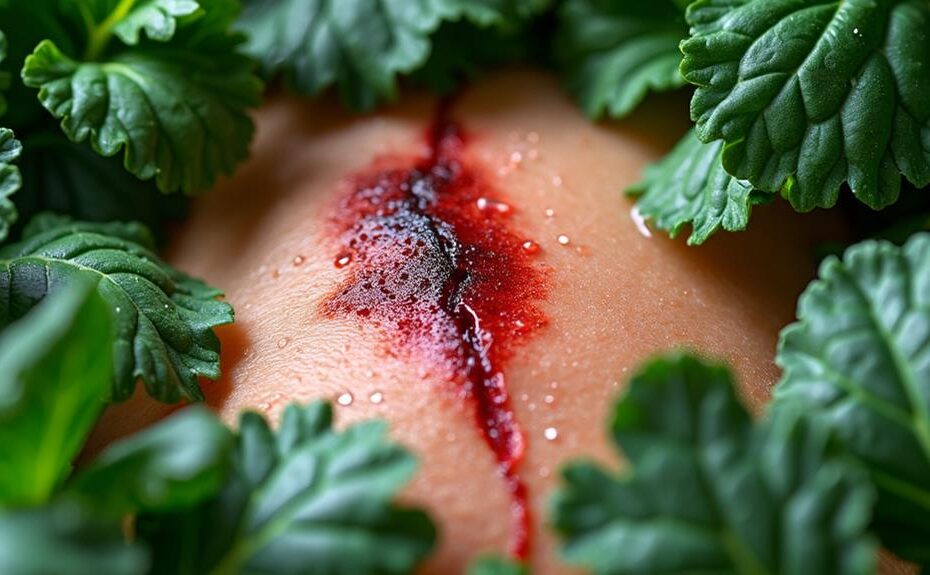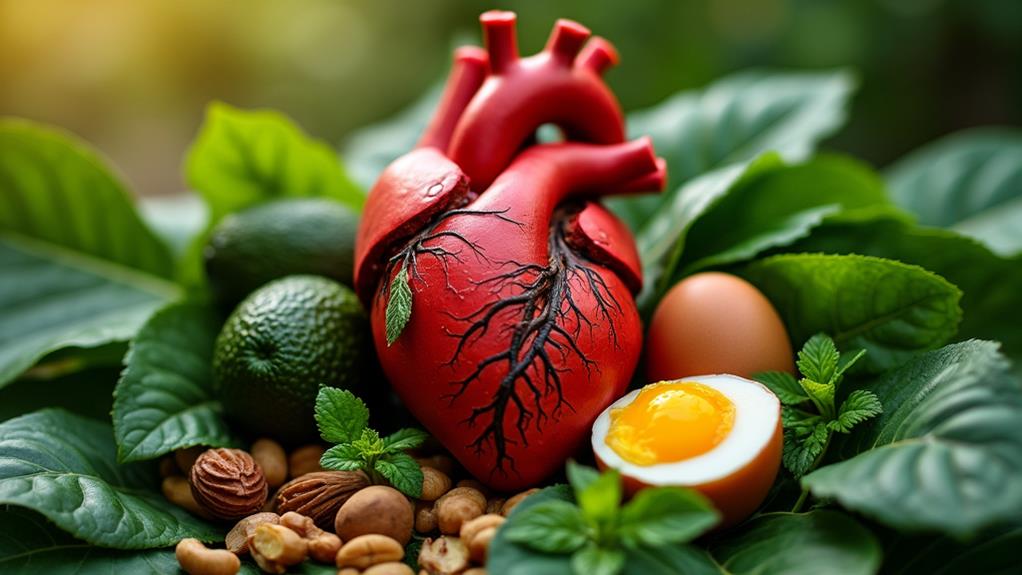







Vitamin K1 supports wound healing primarily by enhancing blood clotting and collagen synthesis. It activates proteins essential for coagulation, which helps seal wounds and prevent bleeding. Additionally, Vitamin K1 boosts fibroblast activity and collagen formation, essential for tissue repair. Its antioxidant properties reduce oxidative stress, creating a favorable healing environment. Clinical evidence shows that topical application of Vitamin K1 can considerably lower healing time in wounds. For ideal results, apply 1% Vitamin K1 cream to clean wounds regularly. To explore further benefits and applications, you'll find more details beneficial to your understanding.
Key Takeaways
- Vitamin K1 is essential for blood clotting, synthesizing proteins that control bleeding and promote effective wound healing.
- It enhances fibroblast activity, boosting collagen synthesis necessary for tissue repair and structural integrity.
- Vitamin K1 promotes angiogenesis, facilitating the formation of new blood vessels crucial for delivering nutrients to healing tissues.
- Topical application of Vitamin K1 accelerates wound healing rates and improves epithelialization, reducing healing time significantly.
- Its antioxidant properties reduce oxidative stress, creating a favorable environment for healing and minimizing cellular damage.
Importance of Vitamin K1
Importance of Vitamin K1
Vitamin K1 is essential for wound healing because it directly influences blood clotting, the body's first response to injury. This vitamin is important for synthesizing proteins that facilitate coagulation, ensuring that bleeding is promptly controlled. Furthermore, Vitamin K1 considerably enhances fibroblast activity, which boosts collagen synthesis and promotes effective tissue repair at the wound site. This vitamin also plays a significant role in regulating calcium in bones, which can indirectly support healing by ensuring healthy tissue structure.
By reducing oxidative stress through the regulation of reactive oxygen species (ROS), Vitamin K1 helps maintain a favorable healing environment, preventing further damage to the tissues. Additionally, adequate Vitamin K1 levels are linked to improved angiogenesis, the process of forming new blood vessels. This is essential for ensuring a sufficient nutrient supply and oxygen delivery to the healing tissues, which accelerates recovery.
Incorporating green leafy vegetables into your diet is important, as deficiencies in Vitamin K1 can lead to prolonged bleeding and hinder the wound healing process. To enhance your healing, focus on maintaining adequate Vitamin K1 levels, as it plays a multifaceted role in ensuring that your body responds effectively to injuries and promotes recovery.
Mechanisms of Action
The mechanisms through which Vitamin K1 influences wound healing are multifaceted and important for an effective recovery process. First, Vitamin K1 plays a crucial role in the carboxylation of glutamic acid residues, which is essential for synthesizing coagulation factors that facilitate blood clotting at wound sites. This initial step is critical for stabilizing the wound environment. Additionally, Vitamin K1-rich foods, such as leafy greens and cruciferous vegetables, not only support blood health but also provide essential nutrients that enhance overall healing capacity sources of Vitamin K1.
Furthermore, Vitamin K1 enhances angiogenesis, promoting the formation of new blood vessels. This process improves oxygen and nutrient delivery to healing tissues, greatly supporting overall wound healing. It also regulates growth factors and cytokines involved in the inflammatory response, which is crucial for initiating the healing process.
The vitamin acts as an antioxidant, effectively reducing oxidative stress by decreasing reactive oxygen species (ROS) levels. This action helps prevent cellular damage during the healing process, allowing for a more efficient recovery. Additionally, studies highlight that topical application of Vitamin K1 can greatly accelerate wound healing rates, enhancing both wound contraction and epithelialization. Together, these mechanisms demonstrate Vitamin K1's essential role in promoting ideal wound healing outcomes.
Clinical Evidence
Utilizing clinical evidence, researchers have demonstrated the substantial benefits of topical Vitamin K1 in wound healing. Clinical trials indicate that patients undergoing electrocautery experience a notable reduction in healing time and wound area when treated with Vitamin K1. Statistically meaningful results were observed by day 7, contrasting sharply with placebo treatments. In a randomized controlled trial involving 63 patients, the mean healing time for those treated with Vitamin K1 was 10.6 ± 3.6 mm, compared to 12.4 ± 3.69 mm for the control group, highlighting enhanced therapeutic benefits. Additionally, Vitamin K1 plays an essential role in activating coagulation proteins, which is vital for proper sealing of wounds and preventing excessive bleeding, further emphasizing its importance in wound care support for cardiovascular health.
Moreover, systematic reviews and meta-analyses reveal that Vitamin K considerably increases wound healing rates in animal models, reinforcing its therapeutic potential. The topical application of Vitamin K1 has been shown to enhance epithelialization, promote collagen formation, and improve angiogenesis, all pivotal factors in effective wound healing.
Research supports integrating topical Vitamin K1 as a supplementary treatment in clinical practice, particularly for patients with acute and chronic wounds, ultimately improving patient outcomes. This evidence underscores Vitamin K1's role as a valuable component in modern wound care strategies.
Recommended Application Methods
Topical application of 1% Vitamin K1 cream can greatly enhance wound healing by promoting wound contraction and epithelialization. For best results, confirm that you apply the cream to clean, dry wounds as part of your routine wound care practices. This method has been shown to notably reduce wound area, particularly in acute and chronic wounds, with noticeable effects by day 7 of treatment.
Incorporating Vitamin K1 cream into your healing protocol may yield improved outcomes, especially when combined with other agents like Eucerin or phenytoin. These combinations can help maximize the healing effects of Vitamin K1, facilitating better management of various wound types.
When applying the cream, use a thin layer and gently spread it over the affected area, guaranteeing even coverage. Regular application is key; consider setting a schedule to maintain consistency in your wound care routine. This approach not only supports wound contraction and epithelialization but also enhances overall healing efficiency. By following these recommended application methods, you can actively contribute to effective wound healing, whether dealing with acute or chronic wounds.
Future Research Directions
Ongoing research is essential for uncovering how vitamin K1 enhances wound healing at a physiological level. Future studies should focus on elucidating the specific physiological mechanisms by which vitamin K1 promotes wound healing. Key areas of investigation include its roles in collagen synthesis and angiogenesis, both critical processes for effective tissue repair.
Additionally, exploring ideal concentrations and delivery methods of vitamin K1 could greatly improve therapeutic efficacy across various wound healing scenarios. It's crucial to assess the synergistic effects of vitamin K1 when combined with standard wound treatments, as this could lead to notable improvements in healing rates.
Research should also evaluate the impact of vitamin K1 supplementation on serum levels in patients with chronic wounds, establishing correlations that may inform treatment protocols. To truly understand the effectiveness and safety of vitamin K1 in wound healing applications, larger, well-designed clinical trials will be necessary. These trials can provide high-quality evidence, guiding clinicians in integrating vitamin K1 into wound care strategies for enhanced patient outcomes. Emphasizing these future research directions will help reveal the full potential of vitamin K1 in wound healing.
Conclusion
In conclusion, vitamin K1's essential contribution to clotting and collagen synthesis greatly supports swift wound healing. By boosting blood flow and facilitating tissue regeneration, it fosters faster recovery. As research continues to unfold, the potential for personalized applications promises progress in therapeutic practices. Prioritizing vitamin K1 in your diet could pave the path to prompt healing and improved health. Embrace the power of this potent vitamin for a brighter, better, and more balanced recovery journey.




